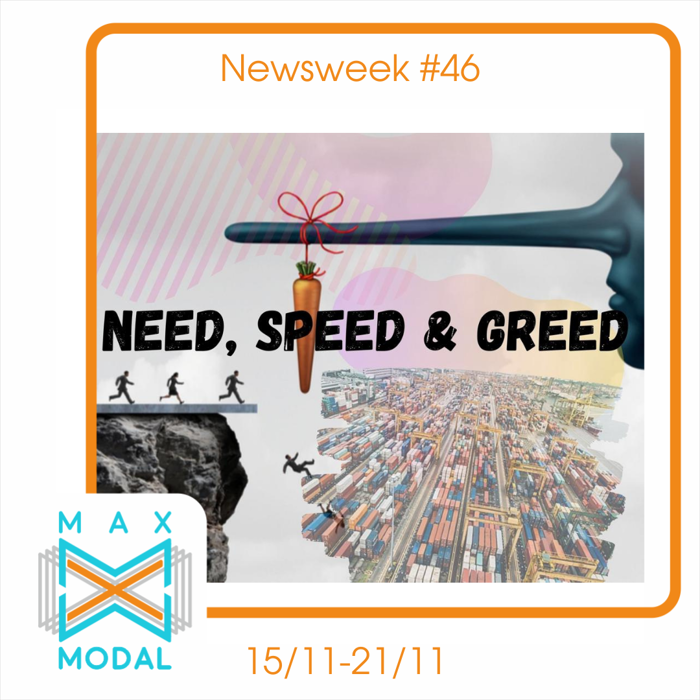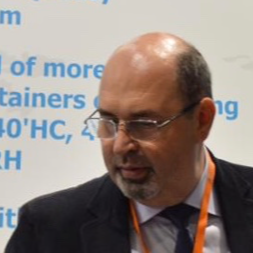All shippers want for Christmas are contracts at a reasonable rate but when you are not the one running the show, matters become much more twisted.
The end of contract season is crippling behind shippers’ backs, but the prospects are not that bright because so far, it is only the shipping lines that are bathing in full glam and glory. They are forcing shippers into long-term contracts and on some tradelines such as the transatlantic one, are refusing to open negotiations on contract renewals. It is now obvious who is running this show. The situation is spiced up with the new spike in freight spot rates by 16.3% in the month of November, and the dynamic is not promising to slow down. The same is happening with airfreight where in some directions the rates are up to $20 per kg with the prospects to remain elevated in 2022. Many shippers are now hanging right above the abyss of uncertainty because they realize that those long contracts will be secured at those impossibly high rates. Will it be worth it to spend so much for the sake of having their cargo transported? Well, theoretically yes, if the demand stays high, but the new forecasts predict the possible ease in container demand. However, the US market is likely to remain strong because that port disruption will continue to be a contributing factor with congestion still being a significant concern. More companies start chattering their containerships to ensure that their cargo will be in time for Christmas. In order to speed up the improvements regarding cargo unloading in the Port of LA and Port of Long Beach, the government has recently stayed using the incentive of postponing the dwell fees, and it is doing it again. The results from the previous “threats” to imposing the fees have been so fruitful – the twin ports have seen a decline of 37% combined in aging cargo on the docks – that the authorities moved the date until December 6. To strengthen the positive dynamic, The CMA CGM Group will implement an Early Container Pickup Incentive Program for 90 days that will pay the importers for picking up their containers via merchant haulage from all the terminals in LA and Long Beach quickly. They will be able to use this money to offset costs incurred by tensions in their supply chains.
Nevertheless, not all ports can recall improvements in their operations this week. The storm in Canada was so strong that 50+ ships were waiting on Monday to unload at the Port of Vancouver. The emergency alert has been prolonged as well. To solve this problem, the federal government is providing more than C$4m to prepare an undeveloped industrial site to temporarily store empty containers. In the EU, congestion fever does not leave the Port of Felixstowe either where it was originally brought by a lack of truck drivers. The situation on the road remains challenging as road freight prices reach record highs. Maersk has omitted Felixstowe from its AE7 service due to the long waiting time. In China, COVID quarantine requirements are forcing major shipping lines to suspend their feeder operations. Not all of them but only the acceptance of the cargo bound for the ports in the South China area that require the usage of the domestic feeders to reach the final destination. However, China is still getting back on track with the increased throughput that has finally risen 8.4% for the first time since the beginning of 2021. The rising volumes will require more space, thus China Harbour Engineering is teaming up with Gulf Energy in Thailand to build two more container terminals. The initiative will be beneficial for both sides. China implements it as a part of its Belt and Road initiative and the Thai government’s plans to attract foreign investment to the industrial east. The results are yet to come, but the Port of Hamburg is already demonstrating outstanding performance in handling pre-and-post-voyage railborne container transport at as much as 2.1 million TEU. No wonder it has been on China’s interest list for months as a valuable asset. At the same time, the country is benefiting from the recent acquisition of the Tianjin Container Terminal done by Cosco and China Shipping Terminal Development Co. The move is purely strategic: Сosco aims to enhance its work with the OCEAN Alliance and continue to strengthen the Group’s leading position in the Greater China region.
China is also not going to stop its locomotive along the New Silk Road. The tiger has pounced in the direction of collaboration with France – the first eastbound train from Paris to Xi’an will carry high-end French furniture, linen products, cosmetics, and wine. The launch of regular trains has followed suit. Surprisingly such country as Poland where capacity issues regarding intermodal should have been gone for good is struggling with them. Intermodal transport is also severely affected by the lack of free tracks, congested border crossings and slow terminal processes. Experts point out the need to find a solution for a problem that affects rail freight generally, and not just a specific aspect of it. In the west, the rail industry sees a major merge of two of the largest rail operators in the US – Canadian Pacific Railway Limited (CP) and Kansas City Southern.

Maersk is reportedly in the market for a top five forwarder as huge shipping line profits – a combined Q3 ebit of $37.24bn – are expected to disrupt the logistics industry, with air cargo taking a particular interest in the outcome.
Maersk’s well-publicised acquisition of Senator, two 777Fs and leases on three 767-300Fs for its Star Air subsidiary, as well as its move into forwarding, could well disrupt the market.
Then, of course, there is CMA CGM’s decision to set up its own airline, having acquired four A350Fs, two 777Fs and four A330Fs. As owner of Ceva Logistics, like Maersk, the line is looking to become a one-stop shop.
However, in these discussions, it is often forgotten that there are two other vertically integrated airlines: Evergreen, which has ship orders which will double the size of its fleet (it ordered 24 ships for some $1bn in September, and 20 in March, for $2.6bn) owns EVA Air, which made a profit in the third quarter and currently has six 777Fs with one on order.
But there is an even closer example, one that tends to slip under the radar: NYK Line, which owns Yusen Logistics, and Nippon Cargo Airlines (NCA), which has eight 747-8Fs, and a fleet of 747-400s operated by Atlas Air.
There have been no concerns so far, however, with other forwarders using NCA. Last year, for example, Ceva operated 40 charters with NCA. But with Maersk and CMA’s more aggressive moves, will the market look more closely at other integrations?
While Maersk’s and CMA’s moves are nothing new, the amount of money and competition in the market is.
“It’s an interesting move by Maersk, especially as it moves into air logistics. It’s a fast mover and just ahead of CMA CGM,” said one senior air cargo executive. “But what will Evergreen and NYK’s countermove be to ensure competitiveness?”
The executive also noted that this vertical integration could lead to new co-operation on the ground, which could give the companies a competitive advantage over pure airline rivals – like the integrators, and the large global forwarders who compete with own controlled capacity, a growing trend (Atlas Air announced an extension of its agreement with DB Schenker).
“How will the obvious logistics synergy of operations and management – on the ground at airports, trucking, rail – be approached? Will airports and sea ports see opportunities beyond the traditional sea-air mode, and look to a synergy in processes that can really disrupt the industry?
“I think they will – but who will be the first movers?”
Earlier this year, one executive close to CMA noted that the line was likely to develop a sea-air product (although last month it pulled its air services from Dubai).
“CMA has little experience in air freight, which is totally different from sea freight. But there is room to create a solution between sea and air. CMA really deals with shippers with a need for sea and air, and it’s possible to combine those needs.
“There is a good synergy for a multimodal solution. Covid has changed the logistics needs of shippers and forwarders, so this is something quite new.”
For an integrated process on the ground, the sea-airlines might consider buying a handler – but one senior handling executive pointed out that the only way to make money in handling is through big volumes, hence the move towards large global handlers.
But the air cargo executive added: “It is inconceivable that any one of the global handling companies (presently owned by PE companies) would not jump at the chance of a strategic alliance with any one of these groups.”
The handler also questioned how vertically integrated companies would manage their rates.
“It’s better for them when it’s all their freight. When it’s other people’s freight, they come unstuck.”
He noted that CMA CGM Air Cargo had outsourced its sales – with the exception of some 30% of the capacity originally set aside for Ceva – to a GSA, ECS Group.
“The GSAs and forwarders need to make a buck and think they can make money from the airline, but who will pay for that, if it’s all the same group?
“The GSAs will be looking for volumes, but a group company can’t pay more than the GSAs are selling it for – that would make a mockery of it. And if group customers get low rates, the airline won’t be able to support it. High rates via a GSA, and they’ll lose the business.”
Meanwhile, forwarders are already complaining about Maersk’s integrated logistics operations biting into their business, with two telling The Loadstar Maersk had contacted their customers, while at the same time preventing them from booking with the shipping line.
Another warned that he could feel Ceva breathing down his neck when booking with CMA CGM Air Cargo.
And with sources reporting that Maersk is expected to make a purchase of top-five forwarder, the transformation into ‘integrator’ will essentially be complete –potentially leaving ‘pure’ airlines out in the cold.
Interestingly, the most vertically integrated company, Amazon, predicted yesterday it would be bigger domestically than FedEx and UPS by the first quarter of 2022. Source https://theloadstar.com/shipping-lines-vertically-take-off-as-integrators-a-threat-to-air-cargo/

X-Press Feeders has placed an order for sixteen 1,170 TEU dual-fuel newbuild containerships that can operate on regular fuel or green methanol.
The vessels will be built by China’s New Dayang Shipbuilding and Ningbo Xinle Shipbuilding Group, with each of them supplying eight units.
The first boxships will enter X-Press Feeders’ Europe and Americas trade routes by Q4 2023, with all vessels joining the fleet by the end of 2024.
Maersk set the ball rolling for methanol-fuelled boxships earlier this year, with orders for a feeder and a series of larger 15,000 TEU vessels. In recent months, X-Press Feeders has voiced its backing for three forms of propulsion to power the next generation of vessels: methanol, ammonia and atomic.

All bomond of containers business of Russia at the conference "Transcont 2021" in Moscow tommorow. MAXMODAL will take part too. Dinar Gainutdinov will tell about trends container business and multimodal network.
Companies have already decided not to wait for the peak season to hit and dived into hyperdrived sales before supply chain snags cut off the flow of merchandise. A way to cover increased operating costs.
This Thanksgiving not only a turkey will be subject to share but also elevated costs that retailers are facing due to increased rent fees, labor expenses, and decreased stocks. Thus, industry giants are on the run to adjust their strategies and test the waters before the Christmas rush hits the stores by regulating FBA fulfillment fees to partially offset the higher permanent operating costs. On average, the increase will be by 5.2%. Sales in November and December are predicted to grow between 8.5% and 10.5% from last year. In addition, such companies as Amazon are raising monthly off-peak storage fees together with removal and disposal fees, and introducing a tiered rate structure for long-term storage and dim-wight pricing for large standard-size products. No one is Immune to the persisting pressure. However, the first signs on the US market indicate potential positive changes next year as inventory levels have re-bound to the pre-pandemic levels. If the consumer demand abates, this dynamic will continue, although the move to higher levels of stock held in by wholesalers brings its own set of problems. There is still no space in the warehouses that is slowing the movement of goods and containers through the supply chain. As the result, the industry gets stuck in congestion. Companies continue altering their services from North America, Latin America, and the Caribbean. Australia is under a huge risk of becoming a “no go” area as well since it is becoming more difficult to book cargo slots and container detention charges keep mounting. Cyber-attacks at container deport operators additionally disrupt the situation. In the meantime, some become creative when addressing equipment shortages. South Korea teams up with a factory in Vietnam to start its own container manufacturing process. The location allows cutting costs related to land and labor expenses.
The global character of the crisis makes the recovery more complicated. Despite the slight aforementioned improvements, the freight costs will remain exceptionally high and consequently drive an increase in prices. Experts predict that on a global scale import price levels could jump by 11%. Recent data proves that the main problem in disrupted schedule reliability is poor service rather than constantly blamed high spot rates. Another tumbling stone is whether shippers are at all willing to pay a premium for better schedule reliability.
An additional overview of the current trends and their effects will be delivered by the FMC shortly to help the flow of cargo through the international supply chain. Transparent data sharing will be the next initiative to be implemented. Another initiative to address the logjam at the ports has sparked the talks in the State – the proposal to launch a new line between the US and China that will use 53-foot containers. While it is still in the talks, Amazon reportedly has backed it. The transpacific direction will play a key role in the future recovery. Currently, the freight transit time remains extremely high. For example, a 32-day transit time is still 68% higher than it was in May 2021 and double the usual transit time. It means that delays are happening at every step, even when containers are unloaded. Apart from transit, delays concern berthing and dwell time. To illustrate the chaos, there are currently around 78 container ships in the queue outside San Pedro Bay. The best way for the companies to avoid continuous delay so far has been the approach to have their own terminal facilities at congested ports.
Alternatively, they can follow the UK’s example that illustrates how the country has shifted its focus at the development of the freeports eco-systems. The new steps aim to attract businesses, thus anyone willing to set up a new manufacturing, clean energy or logistics business at the Thames Freeport will benefit from the access to tangible economic benefits which are available across the main tax sites. This alone will allow companies to reduce ownership costs by 50% - a miracle in our times when the prices keep rising.
When the marine sector fails, it is usually the rail that is put on the pedestal of the hopes and dreams of the future. It has seemed like all leaders have been calling for more investments in railway infrastructure, however, the new studyhas shown that the reality is far from what the media has painted. There is no sign of a modal shift to rail and it is the road sector that is a current priority, at least for the EU. Between 2007 and 2020 82.5 billion went to roads and motorways in comparison to 62 billion euros for rail. The numbers speak for themselves. At the same time, MSC sees inland transportation as a big opportunity and plans to provide a new overland service that will ensure a shorter journey for cargo bound for Saudi Arabia and other Gulf Cooperation Council countries. It will be of particular interest to those shippers that deal with refrigerated cargo. The company also does not slow down on expanding its fleet targeting the second-hand market. The advantage of this strategy is simple: instead of waiting for years for the vessels to be built, MSC will receive them in a much shorter time. Another four ships will join the marine giant’s forces.


Shipping lines have done unimaginable and destroyed even the tech atlantes. A wracking ball that is worthy billions of dollars.
Shipping lines triumph has taken off. Now they definitely have everyone’s attention, even of those who come from different industries such as tech. The reason for it is their resounding success in surpassing the profits of the biggest companies such as Facebook, Amazon, Netflix, and Google. It is difficult to recall any other industry that managed to achieve such accomplishment especially in the time of the crisis. The wealth of some of the marine giants reportedly reaches up to $5.6 billion, a massive growth from $567 million in the same period last year. The records do not end just there. Despite the persisting bottlenecks, the Port of LA is still being number one in handling TEUs. The updates report 902,644 TEU, which is an 8% decrease from last year, however, the overall cargo is up to 22%. More is yet to come with agencies forecasting a record holiday season coming up. However, the industry knows the examples when too rigid anticipation for growth has caused inventory backlogs. Besides, the situation is perplexed with China’s recent decision to ban many reefer shipments through the port of Dalian due to the COVID outbreak. Hapag-Lloyd is advising customers to divert reefer containers to other ports such as Tianjin and Qingdao. Such drastic contrast – either cosmic profits or earnings going down 50% in other sectors is causing extraordinary volatility in the shipping sector. It is an extremely tricky time for the investors as, accosting to experts, the “level of whiplash” over the past couple of years, has been bruising even for the most nimble ones.
The geographic area of booming TEUs is not limited just to the US – Australia previously announced its skyrocket demand, and, according to the October assessment, the Port of Sydney has handled 1 million containers. Since the dynamic is not going to slow down, the port authorities realize the importance of clearing out the space. Apparently, the best way to make shippers move is to threaten them with dwell fees. It worked in the beginning and is working now. The number of container vessels waiting in San Pedro Bay to unload at the ports has dropped from a high of 83 on November 12 to 61 on November 22. Way to go for the ports of LA and Long Beach. In the meantime, the latter has been connected with South China thanks to the linkage introduced by Orient Overseas Container Line.
Rail has also enjoyed its fair share of the blooming volumes, although not without operational problems that arise due to political tension with China and even the ghost of suspension in operation with Lithuania. Congestion in Kaliningrad brought its disruptions as well because the city was a promising transition hub to Belarus. It is reported to remain severe, so China Railway Express trains are gradually shifting back to the Mala-Brest rail line. Meanwhile, Ukraine takes the complicated context as a chance to promote itself as an alternative gateway to Western Europe and is building a 100,000 teu-capacity terminal at Mostyska, on the border with Poland. The expansion of any kind requires significant investments, and in the case of Turkey, the government is planning to increase financial contributions by 60%. The Kars Logistics Centre is in the spotlight as it is the primary tool of the government’s policy to attract more traffic from the New Silk Road via Turkey. In addition, it is aiming to influence the main traffic flows passing through Russia. Is it realistic or ambitious? However, not all initiatives coming from “above” are destined to be accepted. The UK’s Integrated Rail Plan has received negative feedback from the Railway Industry Association. The document was a long-awaited one, but after it was out, it confirmed the speculations that rail projects in the north of England would be scaled back or abandoned. The representatives of the national trade body have voiced their readiness to cooperate and discuss the further steps at the round table. The situation is much clearer in Vancouver now as the storm has died down and Canadian Pacific will restore rail service in British Columbia. A new line connecting Italy and France will also be launched shortly. Calais-Domodossola line will be available for all types of units and it is the first time when Cargobeamer has its own terminal, which makes the work more efficient now. Another advancement in intermodal has seen the light in Poland where Contargo has established a national company. The world can potentially see a new promising player in Eastern Europe, especially since with an annual transport volume of 2.1 million TEU, Contargo is one of the largest container logistics networks in Europe.
Airfreight has definitely been hit among the hardest with the jumped demand and won the pedestal of the most under-invested in the recent news headlines. To address the pain points, DHL is going to expand its international fleet with a far-reaching forecast that the global freighter fleet will be 70% larger than the pre-pandemic fleet by 2040. Beyond added capacity, the additional freighters will allow DHL to fly eco-friendlier and more cost-efficiently. Rival Airbus is also benefiting from growing freighter demand, thanks to the orders made by CMA CGM Group.

Worldwide bottlenecks have been around for weeks now and, although local governments are spending millions of dollars and port authorities are trying numerous strategies from 24/7 work schedules to lifting restrictions, the situation goes on. The benefits that shipping lines and, apparently, forwarders are preventing congestion from resolving. The snail pace that the latter are picking up their containers causes more delays, and even FMC does now have enough regulatory tools to interfere. However, not everything is stuck – California’s ports report improvement. Meanwhile, the East is planning major changes as well with China intending to make the local ports more attractive to foreign investments.
Investments are the key indeed, and airfreight knows it like no other. Years of the lack of financial funding have resulted in the inabilities of the sector across the current crisis. Even with the introduction of new services, the increased capacity adds nothing to the battle against congestion and sky-high cargo rates. It is crucial to keep in mind that not only traditional horsemen of the crisis (shortages, congestion, elevated rates) can add logs to the fire, but the weather as well. Canada’s railways and ports are struggling with floods, and there are no alternatives to divert the traffic. Will new technologies and digitalization speed up the transition to more resilient systems? Follow MAXMODAL for more updates.








